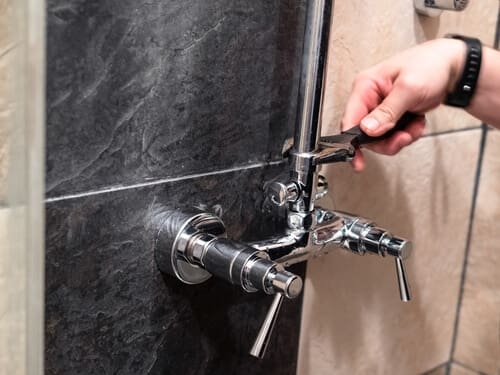
A properly functioning shower valve is essential for controlling water flow and temperature in your bathroom. When problems arise, such as inconsistent water temperature, leaks, or low water pressure, they can disrupt your daily routine. If you live in San Diego, San Marcos, El Cajon, or the surrounding areas, knowing whether you can fix your shower valve yourself or if you should call a professional can save you time and money.
Understanding Shower Valves
A shower valve is the mechanism behind the scenes that controls your shower’s water pressure and temperature. When it works correctly, you likely don’t even think about it. However, when something goes wrong, it can lead to significant frustration.
Shower valves are built to last, but wear and tear, mineral buildup, and faulty components can cause issues that require attention over time. Understanding how your shower valve operates and the signs of trouble can help determine whether you need a simple repair or a full replacement.
How Shower Valves Work
Shower valves blend hot and cold water from your home’s plumbing system to deliver the desired temperature and pressure. There are three main types of shower valves:
- Pressure-Balancing Valves: These maintain a consistent water temperature by adjusting to changes in water pressure. They are great for preventing sudden temperature fluctuations when someone flushes a toilet or runs a sink.
- Thermostatic Valves: These allow users to set a specific water temperature. They provide greater control and are ideal for households with young children or individuals sensitive to temperature changes.
- Diverter Valves: Found in combination bathtub/shower setups, these valves direct water between the bathtub faucet and the showerhead.
The type of valve in your shower will determine how repairs and replacements are handled.
Common Issues with Shower Valves
Shower valve problems can result in a range of frustrating issues. Here are some of the most common problems homeowners encounter:
- Leaky Showerhead or Faucet: If water drips from the showerhead after turning off the faucet, the issue may be a worn-out washer, O-ring, or faulty valve cartridge.
- Difficulty Adjusting Water Temperature: A malfunctioning pressure-balancing or thermostatic valve could be the culprit. If you notice sudden temperature changes, the cartridge may need to be replaced.
- Low Water Pressure: A clogged or deteriorating shower valve can restrict water flow, leading to weak pressure. Mineral deposits from hard water can also contribute to this issue.
- Water Won’t Shut Off Completely: If the shower continues running despite turning the handle off, the valve may fail and need replacement.
If you’re experiencing other plumbing issues in your home, check out these common signs of a leak [1].
DIY Shower Valve Repair
Some shower valve issues can be repaired without professional help. If you enjoy tackling home improvement projects, follow these steps for a simple shower valve fix.
Tools and Materials Needed
Before getting started, gather the necessary tools and supplies:
- Adjustable wrench
- Screwdriver
- Plumber’s grease
- Replacement cartridge or washers
- Pipe tape
- Needle-nose pliers
Replacing a Shower Valve Cartridge
A worn-out cartridge is a common cause of shower valve problems. Replacing it can often restore proper water temperature control and prevent leaks. Follow these steps:
- Turn Off the Water Supply: Locate your home’s main water shutoff valve and turn off the water supply to prevent flooding.
- Remove the Shower Handle: Use a screwdriver to detach the handle, then remove the escutcheon plate to access the valve.
- Extract the Old Cartridge: Carefully pull out the old cartridge using pliers. If it’s stuck, a cartridge removal tool may be necessary.
- Install the New Cartridge: Apply the plumber’s grease to the new cartridge before inserting it into the valve body. Ensure it’s aligned correctly.
- Reassemble the Shower Handle: Reattach the escutcheon plate and handle once the new cartridge is in place.
- Turn the Water Back On: Restore the water supply and test the shower to make sure the issue is resolved.
Choosing the Right Shower Valve
Selecting the right model is essential if a repair isn’t enough and you need a complete shower valve replacement. Here are some factors to consider:
- Compatibility: Make sure the new valve matches your existing plumbing setup. Some models require modifications to your pipes.
- Water Efficiency: Consider a water-saving model to help reduce your water bill while maintaining firm pressure.
- Material Durability: Brass and stainless steel valves are more durable and longer-lasting than plastic alternatives.
Explore our plumbing services [2] for expert guidance and to find the best solutions for your home.
When to Call a Professional
While DIY repairs can fix minor issues, some shower valve problems require professional attention. You should call a licensed plumber if:
- There’s a leak behind the wall: Hidden leaks can cause water damage and mold growth.
- The valve is corroded or stuck: If it doesn’t budge, attempting to force it out can damage your plumbing.
- You’re experiencing persistent temperature fluctuations: This could indicate a deeper issue within your home’s plumbing system.
- Your home has low water pressure throughout: This might signal a more significant problem affecting multiple fixtures.
At Anderson, we specialize in bathroom plumbing [3] and fixture repairs [4]. Our expert technicians provide high-quality service and solutions in San Diego, San Marcos, El Cajon, and the surrounding areas. Don’t let a faulty shower valve disrupt your home – contact us today [2] to schedule an appointment.